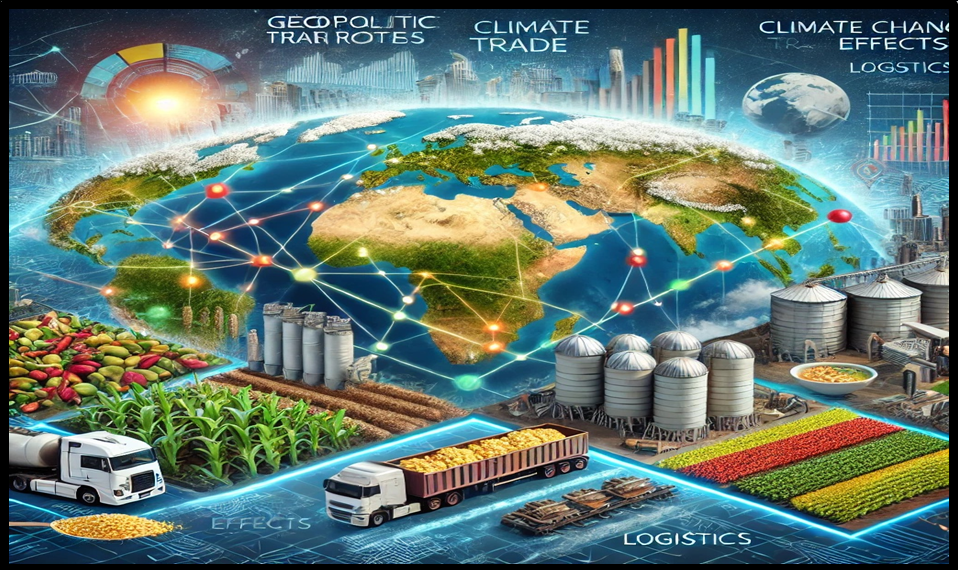GEO TENSIONS, FOOD INSECURITY DRIVING FRAGMENTATION OF AGRI TRADE; DOMESTIC PRESENCE KEY
Source:scribd
Relevance:
GS 3 – Issues related to Direct and Indirect Farm Subsidies, Public Distribution System, Food Security, Technology Missions.
Focus:
- The shifting geopolitical environment and food insecurity are profoundly affecting global agricultural trade.
- This analysis explores the factors driving increased volatility in agricultural production and trade, emphasising the need for a robust domestic presence to address these challenges.
Key Drivers of Volatility
- Geopolitical Tensions: Recent years have seen increased geopolitical tensions that disrupt global supply chains, causing volatility in agricultural production and trade. This includes trade wars, sanctions, and regional conflicts.
- Climate Change: Negative weather conditions, such as El Niño, have led to significant variations in agricultural output, influencing global supply and demand.
- Logistics Disruptions: The COVID-19 pandemic has caused major logistical issues, including shipping delays and higher transportation costs, which aggravate volatility in agricultural trade.
- Economic Policies: Protectionist policies and changes in trade tariffs affect agricultural exports and imports, leading to market fragmentation.
Impact on Agricultural Trade
- Fragmentation of Trade: The fragmentation of agricultural trade is altering the industry. Companies are focusing on strengthening domestic supply chains to ensure stability and lessen reliance on global markets.
- Commodities Trading: Major commodities traders like Louis Dreyfus Company (LDC) are adjusting by improving domestic distribution networks and investing in local production facilities.
- Market Volatility: The volatility in global markets requires traders to be more agile and responsive to shifts in supply and demand dynamics.
India’s Self-Sufficiency in Food Production:
- Supply and Demand Dynamics: India has made significant progress in achieving food production self-sufficiency. Its diverse climate supports the cultivation of various crops, reducing import dependence.
- Domestic Market Focus: Companies are investing in the domestic market to build resilience against global disruptions, including facility upgrades, efficiency improvements, and consistent supply to meet local needs.
- Policy Support: Government policies, such as Minimum Support Price (MSP) and subsidies, are crucial in promoting domestic production.
Strategies for Improving Agricultural Productivity
- Technology Integration: Using advanced technology for crop forecasting, soil health monitoring, and efficient water use can significantly enhance productivity.
- Training and Capacity Building: Collaborating with experts and training local farmers in best practices and innovative techniques can boost productivity and sustainability.
- Investment in Infrastructure: Developing robust infrastructure, including storage facilities, transportation networks, and processing units, is essential for maintaining a stable supply chain.
- Research and Development: Investing in R&D to create high-yield, drought-resistant, and pest-resistant crop varieties can safeguard food production against climate change impacts.
Coffee Futures and Market Dynamics
- Climate Impact: The coffee market has experienced notable volatility due to climatic events like El Niño, affecting production in major coffee-growing regions.
- Market Diversification: Companies are diversifying their markets and reducing reliance on a few key regions by expanding into new markets and investing in local production capacities.
- Consumer Trends: Evolving consumer preferences for sustainable and ethically sourced coffee are shaping market dynamics.
Challenges and Opportunities
- Price Sensitivity: The Indian market’s high price sensitivity necessitates maintaining competitive pricing while ensuring quality.
- Youth Engagement: Involving the younger population in agriculture through education and vocational training can address labour shortages and bring fresh perspectives to the industry.
- Sustainability Focus: Emphasising sustainable farming practices can mitigate environmental impacts and ensure the long-term viability of agricultural production.
- Government Support: Ongoing government support through policies and financial incentives is vital for sustaining agricultural growth.
Global Comparisons
- United States: The US has utilised advanced agricultural technologies and robust supply chain infrastructures to mitigate global disruptions. The Farm Bill offers extensive support to farmers.
- European Union: The EU’s Common Agricultural Policy (CAP) includes measures to stabilise markets, ensure fair farmer living standards, and promote rural development.
- Australia: Australia’s focus on drought-resistant crops and water management systems has helped manage climate change impacts on agriculture.
Socio-Economic Dimensions
- Rural Livelihoods: Agriculture is a major livelihood source in rural areas. Ensuring stable agricultural production can prevent rural distress and migration to urban centres.
- Gender Roles: Women play a crucial role in agriculture, particularly in rural India. Empowering women farmers through training and resource access can enhance productivity and gender equality.
- Health and Nutrition: Stable food production directly impacts food security and nutrition, reducing malnutrition and improving public health outcomes.
Environmental Dimensions
- Sustainable Farming Practices: Adopting sustainable farming practices, such as organic farming, crop rotation, and integrated pest management, can improve soil health and biodiversity.
- Water Management: Efficient water management practices, including drip irrigation and rainwater harvesting, are crucial for addressing water scarcity and ensuring sustainable agricultural practices.
- Carbon Footprint: Reducing the carbon footprint of agriculture through practices like conservation tillage and precision farming contributes to climate change mitigation.
Policy Recommendations
- Integrated Policy Approach: Develop an integrated policy approach that includes agricultural, trade, and environmental policies to address global agricultural trade complexities.
- Public-Private Partnerships: Foster public-private partnerships to leverage resources, expertise, and technology for sustainable agricultural development.
- Regional Cooperation: Strengthen regional cooperation and trade agreements to enhance food security and stability in agricultural markets.
- Investment in Rural Development: Increase investment in rural infrastructure, education, and healthcare to support rural communities and enhance agricultural productivity.
- Climate Resilience: Implement climate-resilient agricultural practices and support farmers in adapting to changing climatic conditions.
Conclusion:
The intersection of geopolitical tensions, climate change, and logistical challenges highlights the critical need for food security and a strong domestic presence in agricultural production. By leveraging technology, investing in infrastructure, and fostering innovation, countries can build resilient agricultural systems capable of withstanding global disruptions.
Mains Question:
Discuss the impact of geopolitical tensions and climate change on global agricultural trade. How can countries build resilient agricultural systems to ensure food security? (250 words)
Source: The Indian Express




